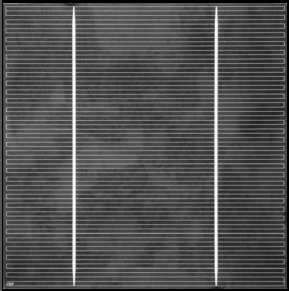C.1 Introduction
At present the fastest-growing renewable energy technology is photovoltaics (PV). This development provides many opportunities for solar cell manufacturers. Manufacturers become more aware of the importance of increasing solar cell efficiency and of the possibilities of designing new types of PV modules with solar cells with an innovative design.
Most of the crystalline PV solar cells have a standard design and appearance. They are blue colored, and the metal contact pattern of these cells is often bounded by an H-shaped pattern (Figure C.1.1). Colors other than blue can be achieved by varying the thickness of the antireflective coating on the top of the cells. This is interesting for PV modules that are implemented primarily in an urban environment, which asks for not only high efficiency but also an aesthetically pleasing appearance.
Figure C.1.1 Solar cell with H pattern

This case considers the restyling of PV modules by modifying the metal contact pattern on multicrystalline solar cells. The main focus is on two-sided contact solar cells, which are usually screen printed on the front side with an H-shaped contact pattern consisting of two busbars that are connected to many smaller contacts, called fingers. Radike and Sumhammer (1999) investigated new possible contact patterns; their paper is the starting point of this case, which was formulated as “the development of a new screen-printed solar cell by designing contact patterns.”
The aim was to explore the possibilities in contact pattern designs and to realize functioning prototypes of the redesigned solar cell. During the project, several parties were involved: solar cell producer Solland Solar, the University of Stuttgart, the University of Twente, and PV module producer Ubbink BV.
In this case description, the design process and results of the research are presented. The design process consists of several steps, which are shown in Figure C.1.2. This case describes two phases: the analysis phase (a and b) and design phase (c). Most of the time spent in the design process is on analysis and pattern design. At the end of this case, conclusions are given that are obtained from the prototype and evaluation phase (d).
Figure C.1.2 Design process

